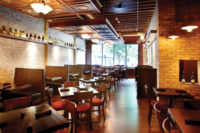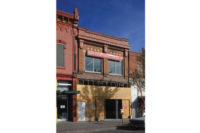Raising the Flag
Largest Chicago fire since 2006 damages Bridgeport neighborhood flag company










Building stabilization, structural clean-up, water and fire damage restoration and drying.
Those were the services that needed to be conducted at Advertising Flag Company. The 52,000-square-foot, two-story office and warehouse space located in the Bridgeport neighborhood on the south side of Chicago experienced significant damage from a fire that occurred at the vacant neighboring former Harris Marcus Group warehouse. The late January 2013 blaze turned out to be the largest fire that the city had seen since 2006.
On January 22, 2013 around 9 p.m. a fire chief passing by noticed the flames and phoned in the emergency. More than 200 firefighters battled the blaze in sub-freezing conditions. Ultimately, it took four hours to get the fire under control. A safety zone was set up around the building to protect against injury and damage to neighboring structures. But that wasn’t all - the next day, firefighters were called back to the scene as the fire had re-ignited, causing more damage to the flag company building. It continued to burn in “hot spots” for the next two weeks.
One-hundred percent of the materials used for making flags suffered from smoke and water damage. Parts of the building were also damaged by water from the sprinkler system triggered by the fire.
As an older building (it was originally built in 1912), the construction consisted of wood timber framing, 12 to 15-foot high wood ceilings and hardwood floors throughout. “Some of the unique design elements included exterior and interior walls with multiple wayths or layers of brick, and many original wood casement windows, and the original entry doors that still open inward,” added J. Murphy, co-owner of Paul Davis National, the professionals that helped restore the facility.
The damage to the flag company building included direct flame damage to windows and masonry, and heavy smoke permeation throughout the structure. “It’s the extreme smoke contamination and the elusive nature of smoke that (made) this loss challenging,” Murphy said. “Due to the style of building, the building materials and the nature of their manufacturing processes, eliminating the smoke odor (was) a significant undertaking.”
The older wood surfaces provide very good hiding places for smoke odor. And, to further complicate the restoration process, the building across the street was so severely damaged, that it needed to be demolished. This would take several months to complete and affect the removal of the smoke odor from the flag company. “Each time the wind blows from a specific direction, more smoke odor is transmitted into the flag company building. This will be an on-going issue for quite some time,” Murphy said.
After a thorough assessment of the Advertising Flag Company’s damage, Paul Davis implemented a simple “dry” cleaning process consisting of HEPA vacuuming of ceilings and walls, damp mopping floors, wiping down flat surfaces including shelves, counter tops, and more, along with cleaning the office windows. As part of the overall cleaning process, workers also removed the floor covering in the company’s showroom.
With the loss occurring in Chicago in January, most of the outside repairs would not begin until spring when the weather was more conducive to working outdoors. The odor issues are largely unknown and will be addressed as an ongoing concern.
While crew members, technicians and local subcontractors worked throughout the building, the Paul Davis team worked with Randy Smith, owner of Advertising Flag Company, his staff and insurance adjusters to ensure that everyone involved was well informed about the damage, crew schedules and equipment needed.
“This was a challenging project dealing with an unpredictable fire emergency in the neighboring old warehouse. We had to act immediately, but at the same time be mindful of the difficulty in ensuring the fire was out in the neighboring property,” said Murphy. “Ultimately, we had to quickly assess the damage, start the work and complete critical parts of the job to keep the business up and running.”
With the uniqueness of this loss, the response plan had to be meticulously supervised. Cost containment and technical accuracy was a critical goal while managing the project. Implementing the correct tactics and techniques in advance of implementation included a proposed plan of action to stabilize and restore the site. All appropriate parties at the customer’s place of business along with the insurance company accepted the proposed plan of action and pricing structure. This allowed the team to establish an agree upon course of action and the work necessary to make effective and efficient decisions, while ensuring that all resources were in place to meet deadlines.
Looking for a reprint of this article?
From high-res PDFs to custom plaques, order your copy today!










